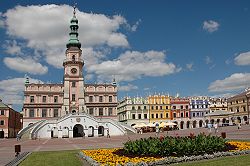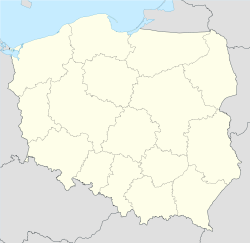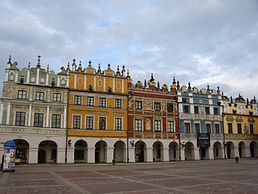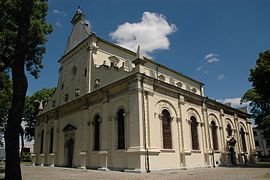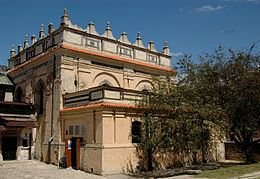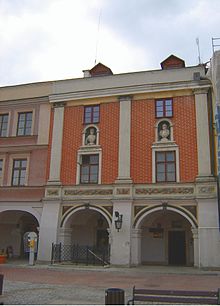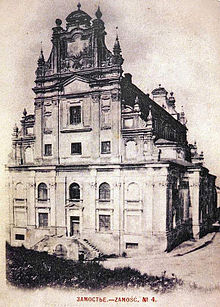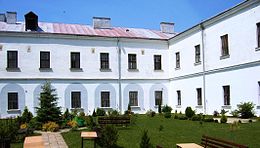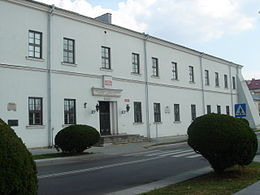- Zamość
-
Zamość City Hall and tenements 
Flag
Coat of armsCoordinates: 50°43′14″N 23°15′31″E / 50.72056°N 23.25861°E Country  Poland
PolandVoivodeship Lublin Powiat City County Gmina Zamość Established 1580 Town rights 1580 Government – Mayor Marcin Zamoyski Area – City 30.34 km2 (11.7 sq mi) Elevation 212 m (696 ft) Population (2006) – City 66,613 – Density 2,195.6/km2 (5,686.4/sq mi) – Metro 140 274 Time zone CET (UTC+1) – Summer (DST) CEST (UTC+2) Postal code 22-400 to 22-410 Area code(s) +48 084 Car plates LZ Website http://www.zamosc.pl Old City of Zamość * UNESCO World Heritage SiteCountry Poland Type Cultural Criteria iv Reference 564 Region ** Europe and North America Inscription history Inscription 1992 (16th Session) * Name as inscribed on World Heritage List
** Region as classified by UNESCOZamość [ˈzamɔɕt͡ɕ] ukr. Замостя is a town in southeastern Poland with 66,633 inhabitants (2004), situated in the south-western part of Lublin Voivodeship (since 1999), about 90 km (55.92 mi) from Lublin, 247 km (153.48 mi) from Warsaw and 60 km (37.28 mi) from the border with Ukraine. About 20 kilometres from the town is the Roztocze National Park.
The historical city centre was added to the UNESCO World Heritage List (in 1992) as a result of the decision taken during the sixteenth ordinary session of the World Heritage Committee, held in Santa Fe, New Mexico, USA, from 7 to 14 December 1992.
In the view of UNESCO, "Zamość is a unique example of a Renaissance town in Central Europe, consistently designed and built in accordance with the Italian theories of the "ideal town," on the basis of a plan which was the result of perfect cooperation between the open-minded founder, Jan Zamoyski, and the outstanding architect, Bernardo Morando. Zamość is an outstanding example of an innovative approach to town planning, combining the functions of an urban ensemble, a residence, and a fortress in accordance with a consistently implemented Renaissance concept. The result of this is a stylistically homogeneous urban composition with a high level of architectural and landscape values. A real asset of this great construction was its creative enhancement with local artistic architectural achievements. Zamość is spoken of as a Renaissance town. However, on the one hand, Morando himself must have had Mannerist training, and on the other, in all the countries of Central Europe (Poland, Bohemia, Slovakia, Hungary, certain German regions and, in part, Austria proper), Italian Renaissance architecture had been well assimilated and adapted to local traditions since the 15th century. Consequently, Zamość was planned as a town in which the Mannerist taste mingled with certain Central European urban traditions, such as the arcaded galleries that surround the squares and create a sheltered passage in front of the shops."[1]
Contents
History
History before World War II
Zamość was founded in the year 1580 by the Chancellor and Hetman (head of the army of the Polish-Lithuanian Commonwealth) Jan Zamoyski, on the trade route linking western and northern Europe with the Black Sea.[2] Modelled on Italian trading cities, and built during the Baroque period by the architect Bernardo Morando, a native of Padua, Zamość remains a perfect example of a Renaissance town of the late 16th century, which retains its original layout and fortifications (Zamość Fortress), and a large number of buildings blending Italian and central European architectural traditions.
At the turn of the sixteenth and seventeenth centuries Zamość was one of the most impressive fortresses in the Polish-Lithuanian Commonwealth. The city was belted with powerful bastion fortifications, curtains and moats. The defensive qualities of the fortress were determined by the natural conditions, since the city was founded at the Łabuńka river and its tributary Topornica river, surrounded by the extensive marshy valley.
As a result of the merger of the fortress and the main city and thanks to the terrain, the fortress had a shape of irregular heptagon, consisting of 7 curtains and 7 bastions placed in the bends. Jan Zamoyski, the founder and owner of the city, paid a lot of attention to the defense functions of the city. In the founding document, he pledged to consolidate the city with ramparts and a moat. The city was founded in the areas that used to be threatened or attacked by the Tatars. In the case of emergency, the powerful fortress could give shelter to people fleeing from threatened areas.[3]
In the 17th century the city was thriving during the most extensive and fastest development period. It attracted not only the Poles but also many other nationalities. The city, however, faced numerous invasions, including the siege by the Cossacks led by Bohdan Khmelnytsky in 1648, the leader of the uprising against the Polish-Lithuanian Commonwealth (1648–1654) which resulted in the creation of a Cossack state, and during the Swedish Deluge in 1656. The Swedish army, like the Cossacks, failed to capture the city. Only during the Great Northern War Zamość was occupied by the Swedish and Saxon troops.
Between 1772 and 1809, the city was incorporated into the Austrian Empire's Crown Province of Galicia.
In 1809 the city was incorporated to the Napoleonic Duchy of Warsaw whereas after the fall of Napoleon, following the decisions taken during the Congress of Vienna in 1815, Zamość became a part of the Kingdom of Poland, also called Congress Poland, which was controlled by the Russian Empire.
In 1821 the government of the kingdom bought off the city and modernized the Zamość fortress. As a result, many buildings were restructured losing their original form and style. The modernized fortress played a big role during the November Uprising in 1830-1831 and surrendered as the last Polish resistance point. The fortress was finally destroyed in 1866, giving rise to the robust spatial development of the city.
In 1916 the city was provided with the railway line. After Poland regained its independence in 1918, Zamość witnessed the outbreak of a communist revolt, suppressed by the Polish troops under the command of Major Leopold Lis-Kula. Two years later, during the Polish-Soviet War, the Soviet army surrounded the city but failed to capture it.
The interwar period was a period of fast city development when its boundaries were widened as well as many new institutions and centers, especially those relating to cultural and educational life, were created.
History after World War II
Following the German invasion and outbreak of World War II, in September 1939 Zamość was seized by the German army. Shortly, the Nazis created an extermination camp in the Zamość Rotunda where more than 8,000 people were killed, including displaced residents of the Zamość region and Soviet prisoners of war.
In 1942, Zamość County, due to its fertile black soil, was chosen for further German colonization in the General Government as part of Generalplan Ost.[4] The city itself was initially to be renamed "Himmlerstadt" (Himmler City), later changed to "Pflugstadt" (Plough City). Reichsfuhrer Himmler visited Zamość in August 1942 and ordered that the buildings of the old city be demolished immediately and replaced by a "German town". The local German administrator, more sympathetic towards the town's Renaissance architecture, played for time by requesting what sort of German architecture was required. Teams of planners and architects had not reached a decision when the Germans were evicted by the Red Army.[5]
The German occupiers had planned the relocation of at least 60,000 ethnic Germans in the area before the end of 1943. Before that, a "test trial" expulsion was performed in November 1941, and the whole operation ended in a pacification operation, combined with expulsions in June/July 1943 which was code named Wehrwolf Action I and II. Around 110,000 people from 297 villages were expelled.[6] Around 30,000 victims were children who, if racially "clean" (i.e. had physical characteristics deemed "Germanic") were planned for germanisation in German families in the Third Reich.[7] Most of the people expelled were sent as slave labour in Germany or to concentration camps.[7]
Local people resisted the action with great determination; they escaped into forests, organised self-defence, helped people who were expelled, and bribed kidnapped children out of German hands.[8] Until the middle of 1943, the Germans managed to settle 8,000 colonists, the number increased by a couple of thousand more in 1944. This settlement was met with fierce armed resistance by Polish Underground forces (see Zamość Uprising). The Nazis found it difficult to find many families suitable for Germanization and so settlement, and that those settlers they did find often fled in fear, because those evicted would burn down houses or kill their inhabitants.[9]
The former President of Germany Horst Köhler was born to a family of German colonists in Skierbieszów.
After World War II, Zamość started a period of development. In the 1970s and 1980s the population grew rapidly (from 39,100 in 1975 to 68,800 in 2003), as the city started to gain significant profits from the old trade routes linking Germany with Ukraine and the ports on the Black Sea.
During the years 1975–1998 Zamość was the capital of Zamość Voivodeship.
Noted conservator and artist Professor Wiktor Zin was responsible for the design and oversight of conservation work on the Arsenal and the Armenian quarter in Zamość.
History of Jews in Zamość
The city was a large center of Chasidic Judaism. The Qahal of Zamość was founded in 1588 when Jan Zamoyski agreed to settle the Jews in the city. The first Jewish settlers were mainly the Sephardi Jews coming from Italy, Spain, Portugal and Turkey. In the 17th century, the newcomers were recruited among the Ashkenazi Jews that soon constituted the majority within the Jewish population. The settlement rights given by Jan Zamoyski were re-confirmed in 1684 by Marcin Zamoyski, the fourth Ordynat of Zamość estate.
At the turn of the 18th and 19th centuries, the Jewish inhabitants were under the strong influence of the Jewish Enlightenment trend called Haskalah. The late nineteenth century saw the spread of Hasidic Judaism. In Zamość there were a Jewish synagogue, two houses of worship and a hospital. Nowadays the best preserved remnant of the Jewish culture is the building of Zamość Synagogue.
In 1827, 2,874 Jews lived in the city. In 1900, the Jewish population was 7,034[10] whereas in 1921 - 9383 (49.3% of the population).
Zamość was the hometown of many prominent Jews, including: poet Solomon Ettinger (1799–1855), writer Isaac Leib Peretz (1852–1915), and future revolutionist Rosa Luxemburg (1870–1919) who were all born there.
Shortly before World War II approximately 12,000 Jews lived in the city. In October 1939, the German occupants set up the Judenrat whereas in the spring of 1942 they set up a ghetto. From April to September 1942, around 4 thousand Jews were deported to the Bełżec extermination camp.
In October 1942, the Germans shot dead 500 people, and the remaining 4,000 were deported, via the transfer point in the Izbica concentration camp, to the camp in Bełżec. The Jews used to be transported in unheated closed, freight train compartments, without any food and water. Many times the relatively short distance travel took 3 days, so the transported people used to arrive already dead. Today only 3 Jews live in Zamość.[11]
Architecture
The most historic buildings are located in the Old Town. The main distinguishing features of the Old Town have been well preserved since its establishment. It includes the regular Great Market Square of 100 x 100 meters with the splendid Townhall and so-called Armenian houses, as well as the fragments of the original fortress and fortifications, including those from the period of the Russian occupation in the 19th century.[12]
Jan Zamoyski commissioned the Italian architect Bernardo Morando to design the city that would be based on the anthropomorphic concept. Its "head" was to be the Zamoyski palace, "backbone" Grodzka Street, crossing the Great Market Square from east to west, in the direction of the palace, and with the "arms" embodied by 10 streets intersecting the main streets: Solna street (north of the Great Market Square) and Bernardo Morando street (south of the Great Market Square). In these streets, the other squares were placed: Salt Square (Rynek Solny) and Water Square (Rynek Wodny), functioning as the "internal organs" of the city whereas the bastions are the "hands and legs" for self-defense.[12]
The most prominent building is the Town Hall, built at the turn of the 16th and 17th centuries in line with Bernardo Morando's design. In 1639–1651, Jan Jaroszewicz and Jan Wolff redesigned the structure. They enlarged the edifice and added three storeys with a high attic. The facades were built in accordance with the Mannerist proportions, regular divisions and excessive architectural décor. The 18th century witnessed the construction of a guardroom and a fan-shaped double stairway that were built in front of the building. In 1770 a slender dome with a lantern was added to the top of the Town Hall tower.[13]


South frontage of the Great Market The Town Hall stands at the foot of the Great Market Square regarded as one of the most beautiful 16th century squares in Europe. The square is surrounded by a complex of arcaded houses that were built by the richest Zamość merchants. Its measure is exactly 100 meters in both width and length with the crossing two main axes of the old town. The 600-meter longitudinal axis goes from the east to the west: from Bastion No. 7 to the Zamoyski Palace. The 400-meter crosswise axis goes from the north to the south, linking the Great Market Square with the two smaller market squares: Solny and Wodny.[13]
The red "Under the Angel" House at 26 Ormiańska street (Armenian street) was built in the early 1630s by a rich Armenian merchant, Garbriel Bartoszewicz. It is embelished with a carved figure of the founder's saint patron, the Archangel Gabriel holding a lily. The walls of the second floor are decorated with lions and a dragon, illustrating that the lions should protect the house against the evil embodied by the dragon. The house is the seat of the Zamość Museum.[13]
The yellow "Under The Madonna" House at 22 Ormiańska street (Armenian street) features the Madonna with the baby Jesus; showing how the Madonna is beating down with her feet a dragon. Built by a Lwów merchant Sołtan Sachwelowicz in the 17th century, the house has been refurbished recently to expose its façade. A high attic has been reconstructed on the basis of old photographs. At present the house is the venue of the Bernardo Morando Fine Arts State Secondary School.[13]
The "Under St. Casimir" House was erected in the 17th century and was owned alternately by Polish chemists and Armenian merchants. The façade of the house is embelished with a figure of St. Casimir, the saint patron of the new owner - Kazimierz Lubecki.[13]
Built at the beginning of the 17th century, the green Wilczek House at 30 Ormiańska street (Armenian street) prides itself in a Baroque decor, including a relief featuring St. John the Baptist and St. Thomas the Apostle with three spears. The house was remodelled in 1665-1674 by Jan Wilczek, a town councillor.[13]
Called also "Sapphire", the blue "Under The Married Couple" House at 24 Ormiańska street (Armenian street) was built in the second quarter of the 17th century by an Armenian merchant Torosz. The facade includes a geometrical and plant frieze whereas the attic is decorated with grotesque figures of a married couple.[13]
The Link House at 5 Rynek Wielki street (Great Market street) was erected at the end of the 17th century with all the features of the Baroque style. A Polish architect Jan Michał Link decorated the façade of the house with fluted Ionic columns. The tops of the windows were embellished with the carved busts of two mythological warriors: Minerva wearing a basinet and Hercules dressed in lion skins. Under the windows there is a frieze featuring laurel and palm branches - symbols of glory and victory. The pilasters include wall-trophies - weapons and armours.[13]
Called also the ‘Chemist's House', the Piechowicz House is a symbol of keeping a 350-year-old tradition. Namely the building, which was built by Szymon Piechowicz from Turobin, a chemist and a professor of medicine at the Zamość Academy, still houses a chemist's. The chemist's is furnished with a set of 19th century dark, oak cabinets.[13]
Constructed by Bernardo Morando for an Italian merchant in the 1590s, also called the Telanowski house, the Zamoyski house belonged to Jan Zamoyski (1599–1657). The house has got four arcades, a frieze placed under the windows and an attic. It was supposed to be a model for other houses located on the square.[13]
The construction of the Second Morando Tenement House started around 1590. It was designed by Bernardo Morando who placed Italian-style regular four-window façade with arcades. The windows are ornamented by a frieze with rosettes. Another frieze is situated on the side wall, showing a combination of rectangles and ovals.[13]
The Abrek House was built for a professor of the Zamość Academy, Stanisław Rosiński. In 1636 the house was bought by another professor of the Zamość Academy, Andrzej Abrek who turned it into a splendid edifice with an arcaded portal, triangular top and three stone doors in the hallway.[13]
Built at the end of the 16th century, the Szczebrzeszyn House belonged to the town of Szczebrzeszyn. Its function was to keep the town's treasures and assets in Zamość fortress that was regarded as a safe place. The house has four windows, arcades and a richly ornamented finial in the form of a cartouche in which Szczebrzeszyn coat of arms was allegedly placed.[13]
Built in the 1600s in line with Bernardo Morando's design, the Turobin House was built for the town of Turobin which used to be part of Zamość Entail. It is embellished with many Renaissance decorations based on Italian models taken from Sebastian Serlia's books. Its façade has got a frieze featuring a system of geometrical figures.[13]
The Cathedral (a former collegiate church until 1992) was founded by Jan Zamoyski and dedicated to Lord's Resurrection and St. Thomas the Apostle. It was built in 1587-1598 by an Italian architect Bernardo Morando. Being 45-meter long and 30-meter wide, the Cathedral constitutes one of the most impressive sacral buildings in Poland. Full of numerous side chapels, thin pillars and a fine vaulted presbytery, it prides itself in original interior decor and rich Renaissance decorations, an 18th century Rococo tabernacle and many paintings of Italian and Polish painters. In the vault of the church, there are crypts with the ashes of 16 Zamość entailers and those of their families.[13]
Built in the Baroque style in the second half of the 18th century, the Cathedral Bell Tower is a prominent structure. It was erected according to Jerzy de Kawe's design. The passageway is decorated with plaques commemorating the martyrdom of the inhabitants of Zamość Region during World War II. In the bell tower there are three historic bells: "Jan" - the biggest and the oldest one, named after its benefactor Jan "Sobiepan" Zamoyski, "Tomasz" founded by Tomasz Józef Zamoyski in 1721 and "Wawrzyniec" founded by Wawrzyniec Sikorski in 1715.[13]
The Redemptorists' Church of St. Nicholas is the former Orthodox church built in 1618–1631. The project was drafted by Jan Jaroszewicz whereas the decorations were designed by Jan Wolff. The domed temple had a defensive purpose. In the 1690s a 38-m tower with a Baroque dome was added. The building has got some features typical of Moldavian Orthodox churches and Latin architecture.[13]
Built in the 1680s in the Baroque style in line with J. M. Link's design, St. Catherine's Church was first dedicated to St. Peter from Alkantara whereas in the 1920s the church became an academic church dedicated to St. Catherine. During World War II, "The Prussian Tribute", the famous Polish painting by Jan Matejko, was transferred secretly from Kraków and hidden in the vault of the church to protect it from the Nazis.[13]
Tomasz Zamoyski, the second entailer, and his wife Katarzyna built The Franciscan Church Dedicated to The Annunciation in the Baroque style. The biggest temple in Zamość (56-meter long and 29-meter wide) was regarded as one of the most prominent 17th century churches in Poland. It was embelished with a very rich décor by Jan Michał Link. In 1784 the Austrians closed down the Franciscan Order and as a result the church lost its sacral function for many years, housing a cinema and secondary school. In 1993 the building was transformed into a church again.[13]
Education
Zamość prides itself in the long history of educational services. The Zamojski Academy (1594–1784) was an academy founded in 1594 by Polish Crown Chancellor Jan Zamoyski. It was the fourth institution of higher education to be founded in the Polish-Lithuanian Commonwealth.
The Academy was an institution midway between a secondary school and an institution of higher learning. It bestowed doctorates of philosophy and law. It was known for the high quality of education that it provided, which however did not extend beyond the ideals of "nobles' liberty.[14]
After the death of Zamoyski, it slowly lost its importance, and in 1784 it was downgraded to a lyceum. The present-day I Liceum Ogólnokształcące im. Jana Zamoyskiego is one of several secondary schools in Zamość.
Nowadays there are 9 secondary schools: 7 public (numbered from 1 to 7), one Catholic and one Social school. In addition, there are 10 primary schools: 8 public (numbered from 2 - 4 and from 6-10) as well as a Catholic and a Social primary school.
High schools
- I Liceum Ogólnokształcące im. Jana Zamoyskiego
- II Liceum Ogólnokształcąse im. M. Konopnickiej
- III Liceum Ogólnokształcące im. K. C. Norwida
- IV Liceum Ogólnokształcące im Armi Krajowej
Colleges
- Wyższa Szkoła Humanistyczno-Ekonomiczna im. Jana Zamoyskiego
- Wyższa Szkoła Zarządzania i Administracji
- Państwowa Wyższa Szkoła Zawodowa w Zamościu
- Zespół Kolegiów Nauczycielskich w Zamościu
- University of Life Sciences in Lublin - faculty in Zamość
Economy
The city is located on the broad gauge railway line linking former Soviet Union with Upper Silesian coal and sulphur mines as well as less than 60 kilometres from the border crossings to Ukraine. Also, Zamość is located on a regular rail line, although it is not electrified. The economy of the city is based on services that is why it is dominated by numerous small and medium-sized enterprises. However, there are some large production plants, mainly food factories and companies, which is related to the dominance of agriculture in the region. These include: the Zamojskie Wheat Company (Zamojskie Zakłady Zbożowe), the Animex fodder company, the Mors frozen food producer, and a daughter company of the Dairy in Krasnystaw.
The city is also a center of know-how support for agriculture and a market for various agricultural products. In addition, the other companies include: a daughter company of the Black Red White furniture company (former Zamojskie Furniture Company), the Spomasz Zamość SA industrial and metal hardware producer, the SIPMOT agricultural machinery producer (a branch of the SIPMA Group from Lublin and a branch of Stalprodukt (former Metalplast) - producer of metal hardware and equipment from Bochnia, listed on the Warsaw Stock Exchange.
Culture
The Old Town together with the remains of the old Zamość Fortress constitute an urban complex inscribed on the UNESCO World Heritage Site. Zamość hosts the following cultural events: concerts of music performed by the Karol Namysłowski Symphonic Orchestra in Zamość and by Polish artists representing different kinds of music, Zamość Days of Music (Zamojskie Dni Muzyki) and International Meetings of Jazz Singers (Międzynarodowe Spotkania Wokalistów Jazzowych), which is a tribute to Mieczysław Kosz, a great blind jazz player and composer who used to combine his jazz music with the Polish folk.
Jazz na Kresach is a very popular annual music festival. It dates back to 1982 and has been held since then. The festival is organised in Zamość Old Town by the Zamość Jazz Club to commemorate Mieczysław Kosz.
The Zamość Festival of Mark Grechuta aims at commemorating his works. He was a composer, singer and poet. The festival has already taken place 3 times: 7–8 September 2007, 6–7 September 2008, 4–6 September 2009. The laureates of the competition and various well-known musicians sang at this festival. The festival is held in Zamość Great Market.
In addition, the admirers of open-air performances can enjoy the Zamość Summer Theatre (Zamojskie Lato Teatralne) whereas enthusiasts of folk art can relish the performances of folk groups from all over the world during the annual "EUROFOLK" International Folk Festival. Lovers of film-making can broaden their knowledge during the Summer Film Academy and the "SACROFILM" International Religious Film Days.
Sports
Zamość is home to a soccer team Hetman Zamość.
Famous and/or known people born in Zamość
See also Category: People from Zamość.- Tauba Biterman (1918 - ) - is a Holocaust survivor that dedicated her adult life to teaching and sharing memories of the Holocaust.
- Joseph Epstein (1911–1944) - also known as Colonel Gilles, was a Polish-born Jewish communist activist and a French Resistance leader during World War II.
- Solomon Ettinger (1802–1856) - was a 19th century Yiddish- and Hebrew-language playwright, poet and writer of songs and fables.
- Marek Grechuta (1945–2006) - was a Polish singer, songwriter, composer, and lyricist.
- Anna Jakubczak (1973 - ) - is a Polish middle distance runner who specializes in the 1500 metres.
- Irene Lieblich (1923–2008) - was a Polish-born artist and Holocaust survivor noted for illustrating the books of Nobel laureate Isaac Bashevis Singer and for her paintings highlighting Jewish life and culture.
- Rosa Luxemburg (1871–1919) - was a Marxist theorist, philosopher, economist and activist of Polish Jewish descent who became a naturalized German citizen.
- Adam Niklewicz (1957 - ) - is an American sculptor and illustrator.
- Zbigniew Nowosadzki (1957 - ) - is a prominent Polish painter.
- Isaac Leib Peretz (1852–1915) - was a Yiddish language author and playwright.
- Mateusz Prus - is a professional footballer, who currently plays for Roda JC in the Dutch Eredivisie.
- Leopold Skulski (1878–1940) - was Prime Minister of Poland from 1919 to 1920.
- Przemysław Tytoń (1987 - ) - is a Polish goalkeeper who plays for PSV Eindhoven in the Dutch Eredivisie.
- Gryzelda Konstancja Zamoyska (1623–1672) - was the wife of Jeremi Michał Wiśniowiecki and the mother of Polish King Michał Korybut Wiśniowiecki.
- Jan "Sobiepan" Zamoyski (1627–1665) - was the 3rd Ordynat of the Zamość Ordynacja estates.
- Aleksander Zederbaum (1816–1893) - was a Polish-Russian Jewish journalist, founder and editor of Ha-Meliẓ, and other periodicals published in Russian and Yiddish.
Coordinates: 50°43′14″N 23°15′31″E / 50.72056°N 23.25861°E
Famous and/or known people connected with Zamość
- Szymon Szymonowic (1558–1629) - was a Polish humanist, poet associated with Grand Hetman and Royal Chancellor Jan Zamoyski, with whom in 1593–1605 he organized the Zamojski Academy.
- Bernardo Morando (ca. 1540-1600) - was a Polish-Italian architect, author of a new town of Zamość, mayor of Zamość.
- Stanisław Staszic (1755–1826) - was a Polish priest, philosopher, statesman, geologist, scholar, poet and writer, a leader of the Polish Enlightenment. He was a tutor for the children of Andrzej Zamoyski, the 10th Ordynat of the Zamość Ordynacja properties.[15]
- Bolesław Leśmian (1877–1937) - was a Polish poet, artist and member of the Polish Academy of Literature, one of the most influential poets of the early 20th century in Poland. He lived and worked as a lawyer (notary) in Zamość.
- Walerian Łukasiński (1786–1868) - was a Polish officer and political activist, sentenced by Russian Imperial authorities to 14 years' imprisonment, he was never released and died after 46 years. He spent 7 years in the tsarist prison in Zamość.
Coordinates: 50°43′14″N 23°15′31″E / 50.72056°N 23.25861°E
Literature
Fritz Stuber, "Notes on the Revalorization of Historic Towns in Poland", in Ekistics (Athens), Vol. 49, No. 295, 1982, pp. 336–341, 3 ill.
International relations
Twin towns — sister cities
Zamość is twinned with OWHC cities as well as:
 Bardejov, Slovakia
Bardejov, Slovakia Loughborough, England, United Kingdom
Loughborough, England, United Kingdom Schwäbisch Hall, Germany
Schwäbisch Hall, Germany Sumy, Ukraine
Sumy, Ukraine Zhovkva, Ukraine
Zhovkva, Ukraine
See also
- Zamojski Academy
- Seven Wonders of Poland
- Zamość Synagogue
- Zamość Fortress
References
- ^ "Old City of Zamość - UNESCO World Heritage Centre". Whc.unesco.org. 2009-09-23. http://whc.unesco.org/en/list/564. Retrieved 2011-09-15.
- ^ "Zamość". Encyclopædia Britannica. http://www.britannica.com/EBchecked/topic/655671/Zamosc. Retrieved 12 April 2011.
- ^ Przewodnik po Zamościu, PTTK O/Zamość, Ryszard Łapa, Edward Słoniewski, Zamość 2005
- ^ Lynn H. Nicholas, Cruel World: The Children of Europe in the Nazi Web p. 333 ISBN 0-679-77663-X
- ^ Mazower, Mark (2008). Hitler's Empire. London: Allen Lane. p. 213. ISBN 978-0-713-99681-4.
- ^ Nicholas, p. 335.
- ^ a b Nicholas, p. 334-5
- ^ Nicholas, p. 334
- ^ Nicholas, p. 336.
- ^ JewishGen.org
- ^ "Zamość Synagogue - Wikipedia, the free encyclopedia". En.wikipedia.org. http://en.wikipedia.org/wiki/Zamo%C5%9B%C4%87_Synagogue. Retrieved 2011-09-15.
- ^ a b A. Kędziora: Encyklopedia miasta Zamościa. Chełm: Towarzystwo Opieki nad Zabytkami, 2000
- ^ a b c d e f g h i j k l m n o p q r s "Zamość". Zamosc.pl. http://www.zamosc.pl. Retrieved 2011-09-15.
- ^ "Akademia Zamojska", Encyklopedia powszechna PWN, vol. 1, p. 36.
- ^ Andrzej Kędziora "Encyklopedia Ludzi Zamościa", Zamość 2007
External links
- Zamość city website
- Zamość article
- Wonders of Zamosc
- Zespół Kolegiów Nauczycielskich w Zamościu
- Kamienice ormiańskie Камяниці Вірменські Հայկական տներ
World Heritage Sites in Poland Auschwitz-Birkenau German Nazi Concentration and Extermination Camp (1940–1945) · Białowieża Forest / Belovezhskaya Pushcha (with Belarus) · Castle of the Teutonic Order in Malbork · Centennial Hall, Wrocław · Churches of Peace in Jawor and Świdnica · Cracow's Historic Centre · Kalwaria Zebrzydowska: the Mannerist Architectural and Park Landscape Complex and Pilgrimage Park · Park Muzakowski / Muskauer Park (with Germany) · Medieval Town of Toruń · Historic Centre of Warsaw · Wieliczka Salt Mine · Wooden Churches of Southern Lesser Poland · Old City of Zamość

Counties of Lublin Voivodeship City counties 
Land counties Biała Podlaska • Biłgoraj • Chełm • Hrubieszów • Janów Lubelski • Kraśnik • Krasnystaw • Łęczna • Lubartów • Lublin • Łuków • Opole Lubelskie • Parczew • Puławy • Radzyń Podlaski • Ryki • Świdnik • Tomaszów Lubelski • Włodawa • ZamośćZamość County Seat (not part of the county): ZamośćUrban-rural gminas 
Rural gminas Categories:- World Heritage Sites in Poland
- Zamość
- Cities and towns in Lublin Voivodeship
- Planned cities in Poland
- Populated places established in 1580
- City counties of Poland
Wikimedia Foundation. 2010.

